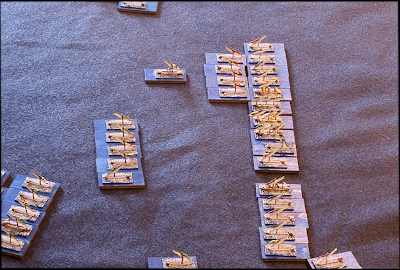Monday was the ninth running of Dave's Annual Naval Game (DANG). This is a tradition among a group of friends. Dave Schueler, former submariner and fellow technical writer, hosts a naval game that gets about 6 to 8 of us together for a day-long operational/tactical naval affair. Dave provided a compendium of DANGs past on his blog Naval Gazing.
For all but DANG I, Dave has provided a small set of possible themes that we can vote on to determine the year's game. This year's voting inclined towards the Battle of Lepanto where Turkish naval forces under Ali Pasha got shellacked by the Holy League lead by Don John of Austria. To put your suspense at ease: no, history was not stood on its head in our game.
The ships were Figurehead/Hallmark 1:2400 scale galleys. Dave bought these in October and painted both fleets in record time. The ships come with their own bases, but Dave put these on 20mm x 40mm Litko 3mm thick wooden bases for better movement and getting the ships to line up in formations better.
 |
| The Christian fleet, galleasses in front |
The first part of the game was an operational phase where each side jockeyed about attempting to raid enemy ports, consolidating our fleets, and seeking out the enemy. The Holy League managed one successful raid on the Turkish-held Dalmatian coast. Our attempted raid on Crete was a disaster resulting in a great loss of fighting crews. We had to slink back to a friendly port to get more soldiers for the fleet.
 |
| The fleets consolidating for the big clash |
Now we rolled to see what our admirals' qualities would be. Of our for admirals, three were sucky and one was merely adequate. This would affect how well we handled our fleets. (The Christians, I believe, rolled better.)
The rules we used for the naval action were Christian Fire and Turkish Fury by David Manley. The rules are an adaptation of the popular American Civil War rules Fire and Fury. Manley's take on the galley-style naval actions is that galley fleets behave more like formations in a land battle than individual ships. He did an earlier set of rules for ancient naval gaming called Greek Fire and Roman Fury, which put shape to his ideas. Christian Fire and Turkish Fury extends that concept to the gunpowder era. It's unclear how to get copies of the rules. They were published in a magazine some time ago. Dave has copies he got from David Manley.
Dave set up the playing area according to his predetermined idea of how coastal islands would feature for any given area on the operational map. The island placement restricted us to a narrow front. The Turkish ships are faster, so we might have attempted a flanking run if we had open water. However, we had to adapt our thinking to what was pretty much a head-on fight.
One restriction to our battle plan was Paul's admiral. Sucky though he was, Hassan, the son of the great Turkish admiral Barbarossa, was a fire eater. The wing he commanded must move at full speed towards the nearest Christian squadron. We lined up with my two Turkish squadrons in line abreast in the center. Paul was on our left in line astern, with the plan to skirt the island there and then form up against the Christian right. Kevin's Barbary squadron, our only elite formation, was behind me as a reserve, and Dave Creager's squadrons were on our right.
 |
| The Turks arrayed |
 |
| The Christian center |
The action started, as expected, with Paul's squadrons meeting the Christian right wing. Paul's two leading squadrons were wee galiots with poor long-range fire. The initial long-range volleys had little effect. But in the ensuing close range fire and melee, Paul's galiots fared for the worse worse. In the first couple turns of the game, our left wing was in severe trouble.
 |
| Christian fire! Dale shoots Paul's lead squadrons |
 |
| The fleets closing in after Paul and Dale's first clash |
 |
| My squadrons engage - poorly |
 |
| Kevin's Barbary squadron makes its presence felt while only two ships remain of my two squadrons |
 |
supported on the right by the remnants of Dave C.'s squadrons |
The day was another DANG success. Much thanks to Dave and his wife Lynn for their hospitality. In addition to a great game, they provide a spread of delicious food. One treat this year were Lynn's rum balls. I haven't had a run ball since the 1970s. My friend Chet's mother used to make rum balls and brandy balls every Christmas and I couldn't get my fill of them. I don't think I ever got drunk on them, but I did retain a fondness for rum well into my 20s.
The day ended with us admiring George's latest model aircraft creations. He's been making masters for 1/285th scale planes for about ten years. He had Phantoms, MiG 21s, MiG 17s, F-105s, and others that were being readied to be sent for casting. It brought to ind how long it's been since we played an air game. We also, discussed options for next year's DANG, although it will be October before we get down to voting on choices.












